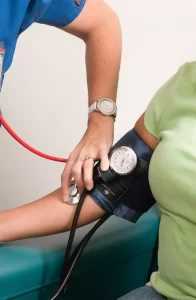A stroke is a life-changing health event that can occur at any age. Though your risk of a stroke doubles every 10 years after age 55, one in seven stroke victims is between age 15 and 49.
Why is a stroke so serious? Though it is possible to recover some functionality, a stroke can cause irreversible damage to your brain. Victims will be impacted by the effects of their stroke for the rest of their lives.
What triggers a stroke? While genetics can play a role in a stroke, preventable diseases and conditions can significantly increase your risk.
Here is a closer look at the effects of stroke and the simple steps you can take to prevent one.
What Is a Stroke?
A stroke is an interruption of the blood flow to your brain. Specifically, it occurs in vessels that transport oxygen and nutrients to the brain. It is the fifth leading cause of death in the United States, but 80 percent of strokes are preventable.
Interrupting blood and oxygen supply to the brain can be fatal to brain cells. Since brain signals control functions throughout your body, strokes often affect other parts of your body. If a stroke is not fatal, it can cause severe symptoms:
- Paralysis or complete loss of muscle movement, which, with time, causes muscle atrophy.
- Difficulty talking and swallowing food, which may require tube feeding.
- Memory loss, thinking or learning disabilities, and emotional problems. People affected by stroke have their brains affected and cannot have the same thinking as before.
- Pain, numbness, and unusual feeling in the part of the body affected by the stroke.
There are two different types of strokes:
- An ischemic stroke is the most common. It occurs when there is a narrowing or blockage in the blood vessel, preventing blood from reaching its target areas. In addition to narrowing due to health issues or bad habits like cigarette smoking, you can also get an ischemic stroke from a blood clot.
- A hemorrhagic stroke is less common, but it can often be more serious. It occurs when a blood vessel bursts and leaks blood into the brain.
Finally, a transient ischemic attack (TIA), or ministroke, is a temporary disruption of blood flow. The blood starts again without any treatment. Physicians often see a ministroke as a warning sign.
Warning Signs of a Stroke
There are several signs of stroke. Initially, symptoms may be hard to detect. However, treatment can be more effective with early identification.
Immediate signs of stroke include:
- Sudden numbness in the face and arm
- Difficulty speaking
- Sudden confusion
- Trouble seeing
- Difficulty in walking
- Severe headache with an unknown cause
While rapid treatment can limit the damage, the best strategy is to prevent a stroke in the first place by dealing with risk factors.
Ways to Prevent a Stroke
Risk factors include high blood pressure, obesity, and poor lifestyle habits, such as excessive alcohol consumption and tobacco use. Dealing with these problems can limit your risk. These steps can be especially important if you have a higher risk for uncontrollable factors like age.
Here are four steps everyone can take to prevent a stroke.
1. Lower Blood Pressure
High blood pressure can increase the chances of getting a stroke. Because blood pressure can burst capillaries, it can lead to a hemorrhagic stroke. Furthermore, hypertension can weaken blood vessels and be a symptom of narrowing veins, which could eventually stop blood flow and cause a stroke.
You can lower blood pressure with cardio exercises, weight loss, and a diet low in sodium, saturated fats, and cholesterol.
2. Decrease Alcohol Consumption
Alcohol use can increase blood pressure, weaken your heart, and narrow arteries. It can also change your metabolism, leading to weight gain, which is another stroke risk factor.
If you are unable to lower your alcohol intake, you can speak with your physician about possible treatment options, including inpatient and outpatient treatment programs and support groups.
3. Quit Smoking
Long-term tobacco use can increase blood pressure, cause heart disease, and thin your blood, which could lead to a hemorrhagic stroke. Nicotine, the substance in cigarettes, is highly addictive, so quitting can be difficult.
Your physician may be able to suggest medication to limit withdrawal symptoms and therapy or stress reduction techniques to deal with the mental aspects of the addiction.
4. Lose Weight
Losing weight can reduce the risk of stroke emergencies. Being overweight can lead to numerous health problems, including diabetes, hypertension, heart disease, and high cholesterol. All these factors increase your stroke risk.
Exercise and dietary changes can help you lose weight, which will immediately lower your risk factors for a stroke. You also need to create a weight management plan to keep your healthy weight.
Work on Stroke Prevention With Matthews Internal Medicine
The specialists at Matthews Internal Medicine can help you take steps to prevent a stroke. In addition to treating conditions that increase stroke risk, our physicians can support you in healthy lifestyle changes, create a weight management plan, and take other preventative measures to reduce your stroke-related dangers.
Contact Matthews Internal Medicine to request an appointment today.


